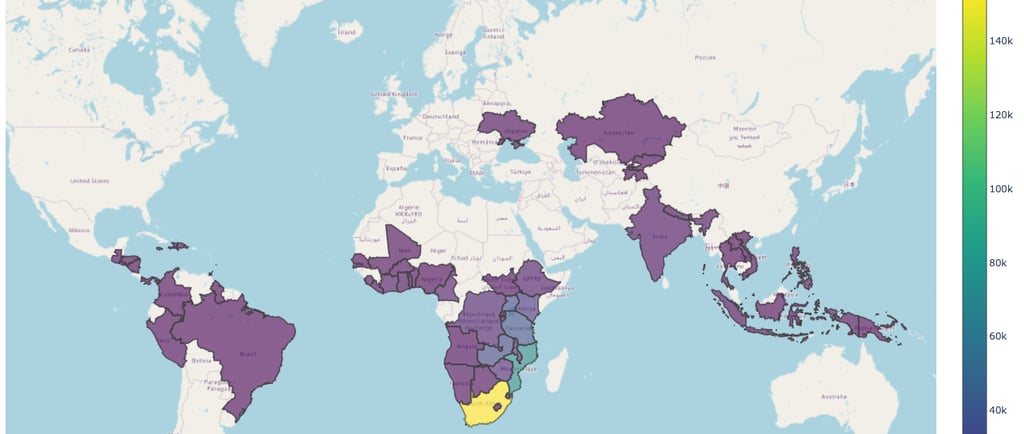Leveraging Data for Impact: A Global Analysis of HIV Index Testing
Discover how data-driven insights from the Public Partner Monitoring, Evaluation, and Reporting datasets help identify the most successful partners and countries in detecting new HIV cases through index testing in 2023. Explore the success metrics, key findings, and recommendations for strategic investment and healthcare initiatives across different countries. Explore the interactive global map of HIV testing success rates here.
10/15/20243 min read


In an era where data drives impactful decisions, understanding the success of global health initiatives becomes critical. This draft report explores the results from the Public Partner Monitoring, Evaluation, and Reporting (MER) Age Sex datasets of 2023, focusing on identifying new HIV-positive cases through index testing. We analyzed the success of various partners across different countries, identifying trends and insights that can shape future health interventions.
Click here to access the full report
The Power of Data in HIV Testing
This project aimed to answer a critical question: Which partners in which countries identified the most new HIV-positive cases through index testing in 2023? By evaluating country and partner-level performance, we uncovered crucial insights into the success rates of HIV index testing across various regions.
The data analysis involved filtering and aggregating data based on key performance indicators, such as the number of positive tests (HTS_TST_POS) and the total number of tests conducted (HTS_TST). Through this process, we were able to determine the highest-performing partners, regions with the most success, and age groups that showed higher testing efficiency.
Key Findings:
1. Top Performers: Partners in countries such as South Africa, Mozambique, and Tanzania identified the highest number of new HIV cases. For example, Partner 13a5b in South Africa detected 83,881 new HIV-positive cases in 2023 with a success rate of 2.7%.
2. Success by Percentage: Smaller countries such as Kyrgyzstan, Tajikistan, and Kazakhstan showed the highest success rates, with some partners identifying new cases with nearly 100% efficiency, albeit from a smaller number of total tests.
3. Success by Age Group: Adults between the ages of 35 and 49 had the highest success rates in HIV testing, indicating that targeted strategies for these age groups might be particularly effective.
You can explore this interactive map that visualizes HIV testing success rates across the globe by visiting our HIV Testing Success Rates Map.
Key Recommendations:
1. Strategic Investment: It’s clear that South Africa, Mozambique, and Tanzania are pivotal in global HIV testing efforts. Funding for partners in these regions, along with additional resources for high-priority countries, could increase testing success and save more lives.
2. Cost-Effectiveness Metrics: Future decisions should also factor in the cost per test and cost per positive identification, allowing for smarter resource allocation. Partners who perform better with fewer resources could serve as models for other regions.
3. Targeted Testing Strategies: With adults aged 35-49 showing the highest success rates, age-specific strategies should be considered for maximum impact.
Data-Driven Solutions for the Future
To ensure the highest levels of success in identifying HIV-positive cases, data from multiple years should be analyzed to track long-term trends and forecast future success rates. Combining this data with metrics like partner funding levels, country GDP, and healthcare infrastructure will allow us to make more informed, impactful decisions on where and how to allocate global health funding.
It’s important to understand what metrics are most important and focus on those. While this report provides an insightful overview based on the available data, it remains a preliminary draft that reflects the limitations of the background information used. In the ever-evolving field of global health, it’s critical to go beyond surface-level data analysis and refine our methods to focus on the metrics that will drive the greatest impact.
By collaborating with subject matter experts in HIV testing, healthcare policy, and international development, we can ensure that future analyses are grounded in the most relevant context. These experts can provide nuanced insights into the challenges and opportunities faced by specific regions, the effectiveness of testing strategies, and the socio-economic factors that influence success rates. For example, they can help identify additional variables such as local community engagement, the role of cultural factors, or access to healthcare services, all of which may play crucial roles in testing success but are often not immediately apparent in raw data alone.
Accessing the Full Report
For more details on the analysis, including insights into individual partner performance and country-specific data, you can access the full document on OneDrive here.
By using data to guide decisions, we can shape more efficient global health programs and continue to improve HIV testing and treatment rates across the world
